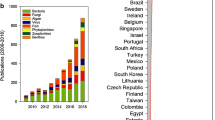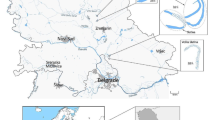Abstract
Arsenic is a heavy metal found in contaminated gold mining areas and which can affect plant and animal species. This study aims to determine the concentration of As in the aquatic plant Colocasia esculenta as well as this plant’s genetic variability. Sediment and C. esculenta samples were collected from three studied sites at the edge of a stream around a gold mine. The arsenic concentrations in sediment and C. esculenta samples were analyzed using induction coupled plasma-mass spectrometry (ICP-MS). Genetic differentiations were studied by random amplified polymorphic DNA (RAPD) with dendrogram construction and analysis of genetic similarity (S). The results showed that the arsenic concentrations in sediment and C. esculenta samples ranged from 4.547 ± 0.318 to 229.964 ± 0.978 and 0.108 ± 0.046 to 0.406 ± 0.174 mg kg−1, respectively. To compare the samples studied to the reference site, RAPD fingerprints from 26 primers successfully produced 2301 total bands used for dendrogram construction and S value analysis. The dendrogram construction separates C. esculenta into four clusters corresponding to their sampling sites. The S values of the studied sample sites compared to the reference site are 0.676–0.779, 0.739–0.791, and 0.743–0.783 for sites 1, 2, and 3, respectively, whereas the values of the individuals within each site are as high as 0.980. These results suggest that As accumulation in aquatic plant species should be of concern because of the potential effects of As on aquatic plants as well as humans.



Similar content being viewed by others
References
Ali, W., Isner, J. C., Isayenkov, S. V., Liu, W., Zhao, F. J., & Maathuis, F. J. (2012). Heterologous expression of the yeast arsenite efflux system ACR3 improves Arabidopsis thaliana tolerance to arsenic stress. New Phytologist, 194, 716–723.
An, L. H., Zheng, B. H., Wang, L. J., Zhang, Y. Q., Chen, H., Zhao, X., Zhang, R. L., & Lei, K. (2012). Biomarker responses and genotoxicity in the mud snail (Bullacta exarata) as indicators of coastal contamination. Marine Pollution Bulletin, 64, 303–309.
Anderson, C. R., & Cook, G. M. (2004). Isolation and characterization of arsenate-reducing bacteria from As-contaminated sites in New Zealand. Current Microbiology, 48, 341–347.
Angelis, K. J., Mcguffie, M., Menke, M., & Schubert, I. (2000). Adaption to alkylation damage in DNA measured by the comet assay. Environmental and Molecular Mutagenesis, 36, 146–150.
Ansari, T., Marr, I., & Triq, N. (2004). Heavy metals in environments in marine pollution perspective—a mini review. Journal of Applied Sciences, 4, 1–20.
APHA. (2005). Standard methods for the examination of water and wastewater (21st ed.). Washington, DC: American Public Health Association.
Bailey, R. M., Stokes, S., & Bray, H. (2003). Inductively Coupled Plasma Mass Spectrometry (ICPMS) for dose rate determination: some guidelines for sample preparation and analysis. Oxford, UK: Oxford Luminescence Research Group, School of Geography and the Environment, University of Oxford.
Cardwell, A., Hawker, D., & Greenway, M. (2002). Metal accumulation in aquatic macrophytes from Southeast Queensland, Australia. Chemosphere, 48, 653–663.
Chen, X. P., Zhu, Y. G., Hong, M. N., Kappler, A., & Xu, Y. X. (2008). Effects of different forms of nitrogen fertilizers on As uptake by rice plants. Environmental Toxicology and Chemistry, 27, 881–887.
Craig, R. A., & Gregory, M. C. (2004). Isolation and characterization of arsenate-reducing bacteria from As-contaminated sites in New Zealand. Current Microbiology, 48, 341–347.
De Wolf, H., Blust, R., & Backeljiau, T. (2004). The use of RAPD in ecotoxicology: a review. Mutation Research, 566, 249–262.
Duan, G., Kamiya, T., Ishikawa, S., Arao, T., & Fujiwara, T. (2012). Expressing ScACR3 in rice enhanced arsenite efflux and reduced As accumulation in rice grains. Plant and Cell Physiology, 53, 154–163.
Frankenberger, W. T., Jr., & Arshad, M. (2002). Volatilisation of As. In W. T. Frankenberger Jr. (Ed.), Environmental chemistry of As. New York: Marcel Dekker.
Groundwater Research Center of Thailand. (2010). Performance report of prevention in environmental impact and environmental monitoring of gold mining project (Phu Thap Pha, Loei Province). Khon Kaen: Performance Report, Faculty of Technology, Khon Kaen University.
Gupta, M., & Sarin, N. B. (2009). Heavy metal induced DNA changes in aquatic macrophytes: random amplified polymorphic DNA analysis and identification of sequence characterized amplified region marker. Journal of Environmental Sciences, 21, 686–690.
Henke, K. R. (2009). As Environmental Chemistry Health Threats and Waste Treatment, 1st ed., John Wiley and Sons. Ltd.
Héry, M., Gault, A. G., Rowland, H. A., Lear, G., Polya, D. A., & Lloyd, J. R. (2008). Molecular and cultivation dependent analysis of metal-reducing bacteria implicated in arsenic mobilization in south-east Asian aquifers. Applied Geochemistry, 23, 3215–3223.
Jackson, B. P., Seaman, J. C., & Bertsch, P. M. (2006). Fate of As compounds in poultry litter upon land application. Chemosphere, 65, 2028–2034.
Liu, W., Li, P. J., Qi, X. M., Zhou, Q. X., Zheng, L., Sun, T. H., & Yang, Y. S. (2005). DNA changes in barley (Hordeum vulgare) seedlings induced by cadmium pollution using RAPD analysis. Chemosphere, 61, 158–167.
Liu, S., Zhang, F., Chen, J., & Sun, G. (2011). As removal from contaminated sediment via biovolatilization by genetically engineered bacteria under laboratory conditions. Journal of Environmental Sciences, 23, 1544–1550.
Pandey, J., Shubhashish, K., & Pandey, R. (2010). Heavy metal contamination of Ganga River at Varanasi in relation to atmospheric deposition. Tropical Ecology, 51, 365–373.
Pollution Control Department of Thailand. (2001). Water Quality Standards. [online]. Available http://www.pcd.go.th/ [2012, August 10].
Rohlf, F.J. (1998). NTSYS_pc: Numerical taxonomy and multivariate analysis system, version 2.1. Applied Biostatistics, New York.
Shahedur, R., Ki-Hyun, K., Subbroto, K. S., Swaraz, A. M., & Dipak, K. P. (2014). Review of remediation techniques for As (As) contamination: a novel approach utilizing bio-organisms. Journal of Environmental Management, 134, 175–185.
Singh, A., Sharma, R. K., Agrawal, M., & Marshall, F. M. (2010). Risk assessment of heavy metal toxicity through contaminated vegetables from wastewater irrigated area of Varanasi, India. Tropical Ecology, 51, 375–387.
U.S. Environmental Protection Agency. (1994). Sample preparation procedure for spectrochemical determination of total recoverable element, method 200.2. Cincinnati, Ohio: Environmental Monitoring Systems Lab.
Violante, A., Gaudio, S., Pigna, M., Pucci, M., & Amalfitano, C. (2008). Sorption and desorption of arsenic by soil minerals and soils in the presence of nutrients and organics. In Q. Huang, P. Huang, & A. Violante (Eds.), Soil mineral microbe-organic interactions. Berlin Heidelberg: Springer.
Weerasiri, T., Wirojanagud, W., & Srisatit, T. (2013). Localized profile of As in sediment and water in the area around gold mine. Current World Environment, 8, 231–240.
Williams, P. N., Lei, M., Sun, G. X., Huang, Q., Lu, Y., & Deacon, C. (2009). Occurrence and partitioning of cadmium, As and lead in mine impacted paddy rice: Hunan, China. Environmental Science and Technology, 43, 637–642.
Zhao, F. J., Ago, Y., Mitani, N., Li, R. Y., Su, Y. H., Yamaji, N., McGrath, S. P., & Ma, J. F. (2010). The role of the rice aquaporin Lsi1 in arsenite efflux from roots. New Phytologist, 186, 392–399.
Acknowledgments
This research was funded by Khon Kaen University under the Incubation Researcher Project, Genetics and Environmental Toxicology (GET) Research Group, and Integrated Water Resource Management Research and Development Center in Northeast Thailand, Khon Kaen University, Thailand.
Author information
Authors and Affiliations
Corresponding author
Rights and permissions
About this article
Cite this article
Boonmee, S., Neeratanaphan, L., Tanee, T. et al. The genetic differentiation of Colocasia esculenta growing in gold mining areas with arsenic contamination. Environ Monit Assess 187, 227 (2015). https://doi.org/10.1007/s10661-015-4462-1
Received:
Accepted:
Published:
DOI: https://doi.org/10.1007/s10661-015-4462-1




